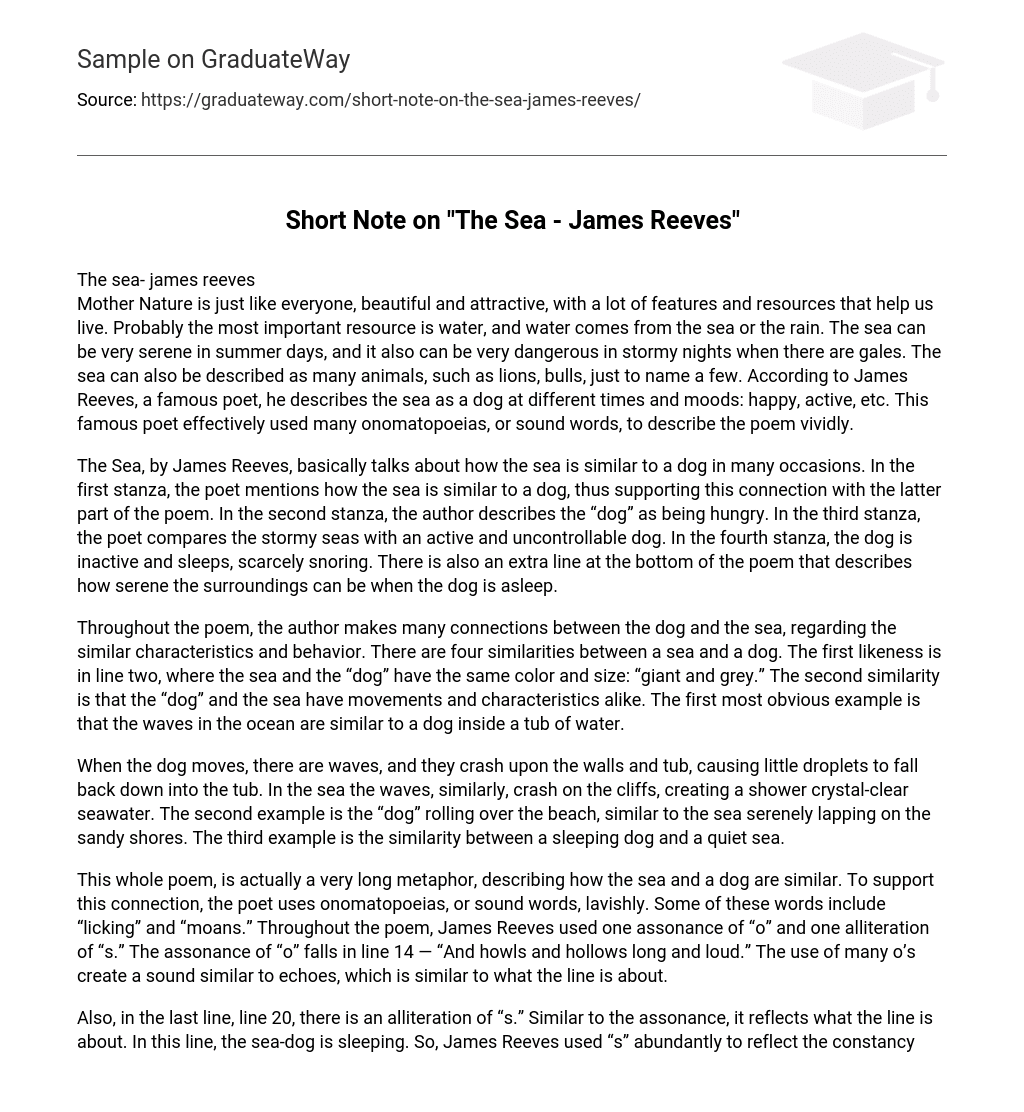The sea- james reeves
Mother Nature is just like everyone, beautiful and attractive, with a lot of features and resources that help us live. Probably the most important resource is water, and water comes from the sea or the rain. The sea can be very serene in summer days, and it also can be very dangerous in stormy nights when there are gales. The sea can also be described as many animals, such as lions, bulls, just to name a few. According to James Reeves, a famous poet, he describes the sea as a dog at different times and moods: happy, active, etc. This famous poet effectively used many onomatopoeias, or sound words, to describe the poem vividly.
The Sea, by James Reeves, basically talks about how the sea is similar to a dog in many occasions. In the first stanza, the poet mentions how the sea is similar to a dog, thus supporting this connection with the latter part of the poem. In the second stanza, the author describes the “dog” as being hungry. In the third stanza, the poet compares the stormy seas with an active and uncontrollable dog. In the fourth stanza, the dog is inactive and sleeps, scarcely snoring. There is also an extra line at the bottom of the poem that describes how serene the surroundings can be when the dog is asleep.
Throughout the poem, the author makes many connections between the dog and the sea, regarding the similar characteristics and behavior. There are four similarities between a sea and a dog. The first likeness is in line two, where the sea and the “dog” have the same color and size: “giant and grey.” The second similarity is that the “dog” and the sea have movements and characteristics alike. The first most obvious example is that the waves in the ocean are similar to a dog inside a tub of water.
When the dog moves, there are waves, and they crash upon the walls and tub, causing little droplets to fall back down into the tub. In the sea the waves, similarly, crash on the cliffs, creating a shower crystal-clear seawater. The second example is the “dog” rolling over the beach, similar to the sea serenely lapping on the sandy shores. The third example is the similarity between a sleeping dog and a quiet sea.
This whole poem, is actually a very long metaphor, describing how the sea and a dog are similar. To support this connection, the poet uses onomatopoeias, or sound words, lavishly. Some of these words include “licking” and “moans.” Throughout the poem, James Reeves used one assonance of “o” and one alliteration of “s.” The assonance of “o” falls in line 14 — “And howls and hollows long and loud.” The use of many o’s create a sound similar to echoes, which is similar to what the line is about.
Also, in the last line, line 20, there is an alliteration of “s.” Similar to the assonance, it reflects what the line is about. In this line, the sea-dog is sleeping. So, James Reeves used “s” abundantly to reflect the constancy when the dog is sleeping. In Aside from the onomatopoeias and onomatopoeias, there is also a repetition of “bones” in line seven. This repetition reflects the constancy of the sound when the dog is gnawing on the juicy bone.
Regarding the form of this poem, it has a free verse, occasionally with some rhyme but lacking rhythm. However, the lack of rhythm actually fits better in this poem. The lacking reflects how the sea is uncontrollable.
James Reeves used several techniques in rhyming and rhythm to reflect what the poem is about. There is a special rhyme scheme throughout the poem, which is not strong at all. However, this rhyming reflects about the “happenings” in that corresponding stanza. For example, the rhyme scheme in stanza two is very constant: b, c, c, c, b. The constancy reflects the “uniform” sound when the dog gnaws on the bone. Another form that also reflects the “happenings” in the stanza, aside from rhyme scheme, is the rhythm. For example, in the last stanza, the dog is sleeping and everywhere is serene and calm. The rhythm in the last stanza (each line), is 9, 9, 7, 7, 7.
It is obvious that these numbers are constant, which corresponds to the “happenings” in the poem. To show the continuity of water, the poet also reflects it in the poem by the special rhyme scheme. In the last line of each stanza and the first line of the next paragraph have the same rhyme scheme, which is c, c. This rhyming is similar to the water in the sea, which is continuous. The poet also uses a lot of enjambment throughout the poem. These enjambment also reflect the flow and continuity of water. The poet also uses a third technique to show the continuity of the water in the sea. Every stanza has five lines, whereas the first stanza only has four. There is also a last line in the bottom. If we bring the bottom line to the first stanza, then each stanza will have five lines. All these techniques show that the sea is continuos and unlimited.
This poem is very scenic and colorful, with every detail described clearly and explicitly. This shows that the poet carefully planned his poem because to reach this goal, the poet has to picture, whether physically or mentally, the scene he plans to describe. So, since he describes every detail distinctly, it shows that the poet has gone through thoroughplanning. This poem, with the help of many onomatopoeias and enjambment, is very scenic and beautiful. James Reeves surely created an exceptional poem by using such amazing comparisons.





